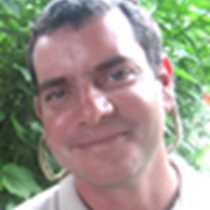Bartolome & Santiago Islands
We had an early start today on Bartolome Island. The sun was just rising and the temperature was perfect. Our goal was to make our way to the summit of this small volcanic island. Bartolome Island has interesting volcanic formations all around. We climbed up 372 steps to reach our goal. Once we reached the top, a beautiful landscape full of colors, from blacks to reds to browns, was waiting for us.
With all that early exercise, our appetites were ready for a well deserved breakfast, just to get more energy to continue on with all the activities in the last day of our expedition around the islands. Later in the morning we disembarked on a paradisiacal golden beach. After a pleasant dune walk, we were ready to go in the water. We had the chance to practice several activities like snorkeling and swimming. The glass bottom boat outings gave us a closer look at the extraordinary underwater Galápagos wildlife, and the water visibility was superb.
In the afternoon we were on our way to Puerto Egas on Santiago Island. This island is one of the largest ones in the archipelago. The dry vegetation we could see from the ship told us that the dry season has just begun. The National Geographic Endeavour anchored and we were ready to disembark once again.
Puerto Egas, our disembarkation place, was at some point inhabited by people for a very short period of time. We observed the ruins of “the salt mine enterprise” that extracted this material from a nearby volcano in the recent past. During the hike we marveled once again with the fauna and flora of the Galápagos. Palo Santo trees, Galápagos doves, Galápagos mockingbirds, Darwin Finches, Marine Iguanas, etc. all have to deal with this harsh and dramatic environment where they carry out their lives.
We went to “the Grottos,” natural pool formations which provide shelter to a small colony of Galápagos fur seals. These creatures came some time ago from the colder waters of the South. It was our time to say good bye to this paradise, a place like no other.
We had an early start today on Bartolome Island. The sun was just rising and the temperature was perfect. Our goal was to make our way to the summit of this small volcanic island. Bartolome Island has interesting volcanic formations all around. We climbed up 372 steps to reach our goal. Once we reached the top, a beautiful landscape full of colors, from blacks to reds to browns, was waiting for us.
With all that early exercise, our appetites were ready for a well deserved breakfast, just to get more energy to continue on with all the activities in the last day of our expedition around the islands. Later in the morning we disembarked on a paradisiacal golden beach. After a pleasant dune walk, we were ready to go in the water. We had the chance to practice several activities like snorkeling and swimming. The glass bottom boat outings gave us a closer look at the extraordinary underwater Galápagos wildlife, and the water visibility was superb.
In the afternoon we were on our way to Puerto Egas on Santiago Island. This island is one of the largest ones in the archipelago. The dry vegetation we could see from the ship told us that the dry season has just begun. The National Geographic Endeavour anchored and we were ready to disembark once again.
Puerto Egas, our disembarkation place, was at some point inhabited by people for a very short period of time. We observed the ruins of “the salt mine enterprise” that extracted this material from a nearby volcano in the recent past. During the hike we marveled once again with the fauna and flora of the Galápagos. Palo Santo trees, Galápagos doves, Galápagos mockingbirds, Darwin Finches, Marine Iguanas, etc. all have to deal with this harsh and dramatic environment where they carry out their lives.
We went to “the Grottos,” natural pool formations which provide shelter to a small colony of Galápagos fur seals. These creatures came some time ago from the colder waters of the South. It was our time to say good bye to this paradise, a place like no other.



